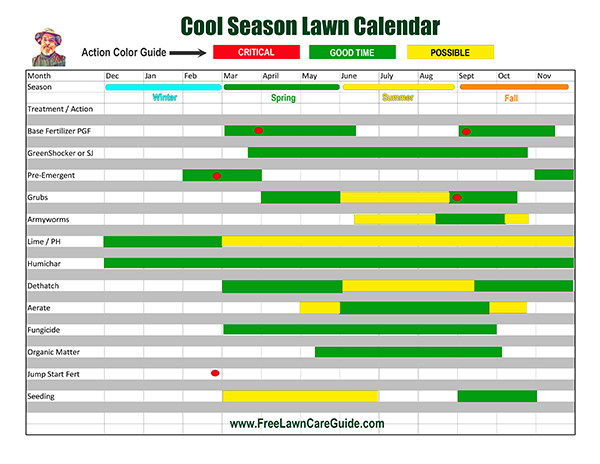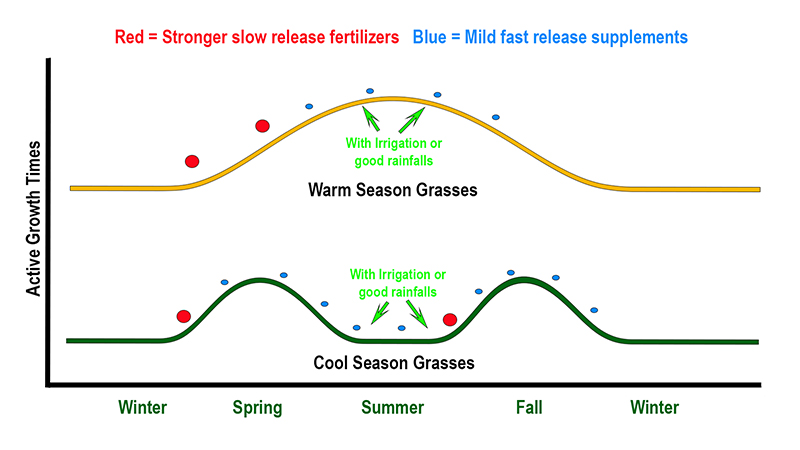Free Lawn Care Guides
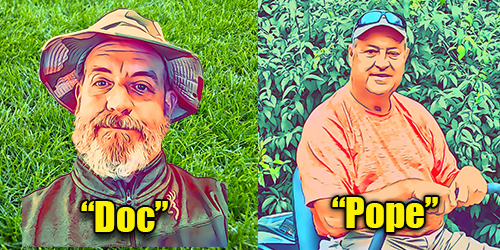
Click below to Meet Doc and Pope
These guides are FREE to use and share. No APP to download, no email signups, nothing. We leave these websites up 365 days a year for use them all you want.
#1 Pick Your Grass Type
Bermuda → HERE
Zoysia → HERE
Cool Season (Fescue, KBG, Perennial Rye) the info is located BELOW / on this website
Before you begin…
#1 You can change the font size and background color by clicking the wheelchair ICON.

#2 You can also read this guide → SUBJECT BY SUBJECT
Pro-Grade Lawn Care Products
We list HIGH QUALITY, professional type lawn care products which have not only been tested, but are developed by the top agronomists, labs, and producers in the turf, golf course, sports turf, industries. Most of these products are NOT available to the average homeowner via “big box stores”. → SEE THEM HERE
Printable Calendar
Click Picture to visit that page. Just a reminder of what need to be done season by season.
Parts of the Grass Plant
All the grasses have leaves, roots, crowns, tillers, and some have rhizomes for spreading.
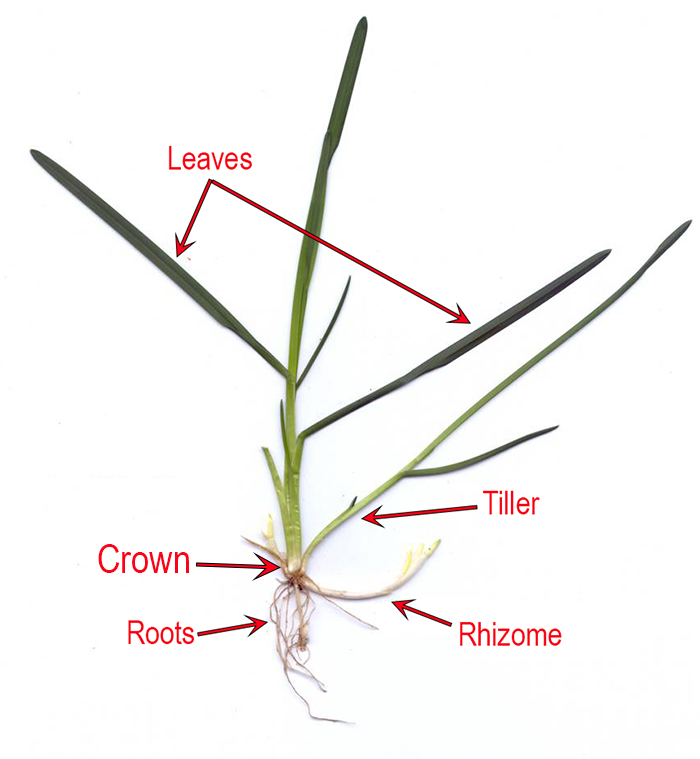
Where to Plant – Zones
Cool season grasses are called such because they don’t perform well in hot southern zones, but often excel in cooler regions. The key is to research the exact variety and how it tolerates your areas annual temperatures. Example: one type of grass may tolerate DEEP cold winters, while another will tolerate milder winters. If planting in a warmer “transition zone” consider improved tall fescue or KBG varieties that are more heat tolerant.
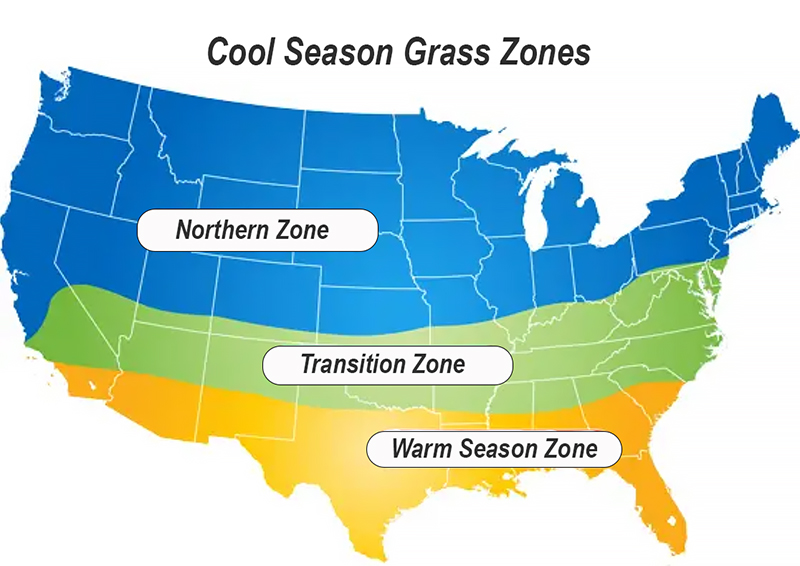 TYPES of Cool Season Grasses
TYPES of Cool Season Grasses
There are 3 BASIC types of cool season grasses. (Keeping it SIMPLE) Fescue, Rye, and Kentucky Blue Grass (KBG). Within these types of grasses there are MANY varieties, and it can get confusing. So, we will first focus on the basics.
Fescue – A non-spreading grass that grows in clumps. These “clumps” spread out slightly via tillers until the lawn is full. (see above) Fescue is the most common cool season grass in the US. Mostly planted from seed, it also comes in sod. The general cutting length is 2.5 to 4 inches and has good drought and traffic resistance. Most fescue has a flat, slightly wider grass blade.It likes full sun but there are varieties that are slightly more shade tolerant. It’s easy care, traffic tolerance and drought tolerance make it one of the easiest cool season lawns to care for. Notes: Many “fescue sods” may contain a mix of another variety such as 10% KBG. Pasture Type tall fescue K-31 has an extremely wide course blade, pale color, and really has no place in a fine lawn.
Fine Fescue vs. Tall Fescue
Like the name implies, fine fescues have a very fine blade and look “soft”. While this look may be desirable, we generally don’t recommend them for lawns. They can be used in shady areas, as many varieties are more shade tolerant. They generally are less drought and wear tolerant and not as “dark green” in color. Most fine fescues do NOT do well in hot, sunny areas. This isn’t a “rule” but rather a suggestion. If you want a softer and shorter lawn, then consider a Rye or KBG. Often Chewings and red fine fescue are chosen for seeding shade areas and do best in those areas. Improved fine fescue varieties are available that have many positives over standard varieties in the shade.
Perennial Rye Grass
A non-spreading grass that grows in clumps. These clumps spread out slightly via tillers until the lawn is full. (see pic above) Perennial Rye Grass is usually planted via seed, but also comes in sod. Cutting height is usually 1.5 to 2.5 inches. It also comes in “sod grade” premium seed, which can be cut very low, down to 1/2 inch via reel mower. There are MANY varieties with various textures, colors, and benefits.
Perennial ryegrass has a fine to medium leaf texture and tends to be dark green. It germinates rapidly and is quick to establish, making it suitable for overseeding. It may be competitive with other grasses, however, and so is sometimes used either alone or in combinations of about 20% perennial ryegrass mixtures with Kentucky bluegrass or fine fescues. It is wear and heat tolerant but will not withstand shade and drought well.
Kentucky Blue Grass – (KBG)
KBG is one of the few cool season grasses that spreads both via tillers and rhizomes. (see pic above) It can be seeded or put down via sod. The average homeowner will cut between 2-3 inches but for those that want a really short cool season lawn, there are high quality, “sod grade”, premium seeds. This type of KBG can be cut down as low as 1/4″ with a reel mower. There are MANY grades, types, and all vary in texture and color. Tolerance is high for cold and wear, and moderate for heat and drought.
The grass becomes semi-dormant during extended hot and dry conditions. It will recover quickly in cooler temperatures and moisture provided the drought was not severe. Kentucky bluegrass is best grown in well drained, sunny areas. It requires a higher amount of N fertilizer (2-4 lb. N/1000 sq.ft. per growing season) than other cool season lawn grasses and may produce a significant amount of thatch.
Mixing Grass Types
Quiet often grasses are mixed. Many “consumer grade” grass seeds in the fescue range are a BLEND of fescues / grasses. However, lawns are often mixed such as KBG and Perennial Rye. This is mostly done for health in relation to both drought tolerance and disease resistance. You need to do research and see which grasses offer which benefits and perform well together. (It gets pretty deep) Our recommendation is that you pick ONE grass to start with and make mixing or blending a FIX for problems. Example: There is no reason to have “shade tolerant” grasses mixed in where the majority of the lawn is FULL, hot sun. Instead, treat those small shady areas with variety that likes shade, but the rest of the lawn in normal seed.
Note: For a stronger stand of turfgrass. Select one type of grass (like Tall Fescue ) in a mix of 3 varieties of improved types recommended for your zone.
Note: Consider improved Tall Fescue or Kentucky Bluegrass varieties that are more heat tolerant if planning a seeding in transition zone.
Extensive article → HERE
Shady Areas
While there are advances in many types of grasses, the grasses that will perform well in more shade are FINE FESCUES and Creeping Red Fescue. However, keep in mind that when you put these grasses in FULL, HOT sun conditions, they don’t perform well. Patience is needed to establish grasses in shady areas, as reduction in light and temperature effect time of seed germination and growth. It’s also recommended by many turf professionals that the cutting height of shady areas be raised taller than other areas. Example: Raising an antenna to get a better signal, and in grass that signal is sunlight.
Seeding Rates
Seeding rates can vary GREATLY between varieties and based on whether establishing NEW lawns, or overseeding existing. Also a grass like KBG will have more SEED PER POUND, smaller grass seeds, than a tall fescue. The majority of seed bag labels will have variety specific seed rates.
Most Important Step
Understanding and improving your soil. When you add fertilizer, supplements, or organic matter to your lawn, you are NOT adding it to the plant. You are adding it to your SOIL. If you’ll learn this first, that a healthy soil makes great lawns, you’ll be way ahead of the game. Think of your lawn soil as a bank for nutrients, managing them well can pay long term benefits for your lawn. So… Step #1, get a soil test.
Soil Testing
Don’t freak out, stick to the basics and don’t read TOO MUCH into your report.
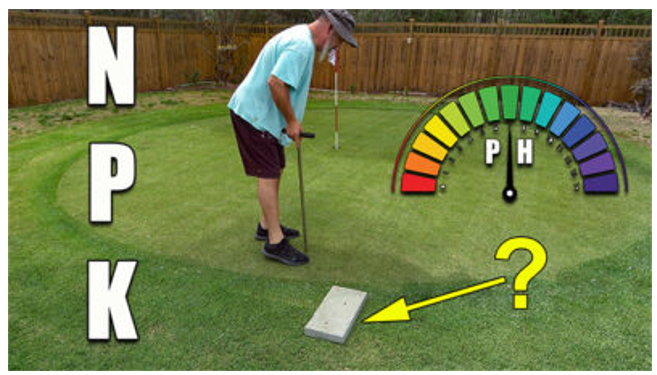
We like to use Clemson for our testing, but you can use whomever you like. Many go through their local extension office. The two critical factors from soil testing is Phosphorus level and PH. There is a page that covers ALL THE INFO about soil testing → SOIL TEST PAGE
On that page Doc goes over what is important and what to focus on. He also walks you through the testing process and how to ship them off. Doc also talks about not “reading too much” into your soil test. He mainly looks for wild spikes and PH levels. Pope recommends you use the same QUALITY testing lab year after year due to varying standards in the industry.
Soil PH
Soils with a pH less than 7.0 are considered acidic, those with a pH greater than 7.0 are alkaline, and those with a 7 are neutral. Most lawn grasses prefer a pH of around 6.5.
Why does this matter? When PH levels start to get too high or too low certain nutrients can either get locked up in the soil, or be depleted easily. (See the chart below.)
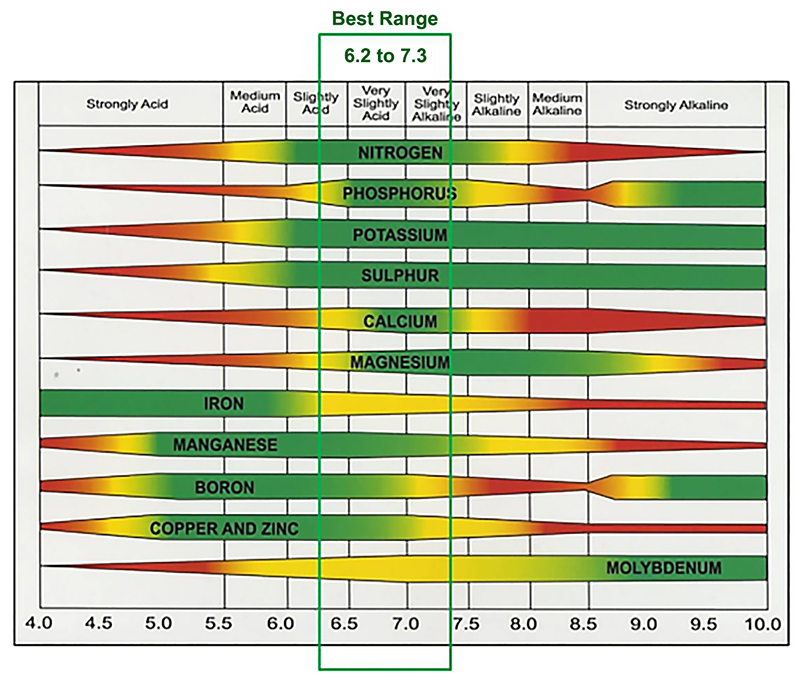
Raising Soil PH
If your lawn PH is low you can apply lime. Crushed lime or pelletized lime can be bought from big box stores but be READY for the weight needed. 50 – 100 pounds of lime per 1000 sq/ft may be needed to raise PH just one point. So, if you have 20,000 sq/ft you may need 40 bags of lime in 40 lb bags. PLEASE… be smart and pay the small delivery charge they have. It will come on a pallet. Cover it with a tarp and apply.
Fast Acting vs Standard Lime
This gets a little complicated so we’ll keep it simple. For the average homeowner… pelletized lime sold at the “big box stores”, is the easiest and quickest way to adjust PH levels UP. Fast acting lime is exactly what it says. It works quicker, but has fewer long lasting impacts on PH. Standard lime, takes much longer to have an impact on PH but lasts much longer. Either is fine on a lawn and we would rather have you focus on reading and following the label on each type.
Lowering PH
If the soil pH is too high (alkaline), it can be adjusted by applying sulfur to the soil. Products commonly available include elemental or ground sulfur, iron sulfate and aluminum sulfate. When needed, most plants will benefit from using any of these products.
Understanding Lawn PH Video
Measure Lawn SQ / FT
The easiest way is to go to Google maps, enter your address, then make sure you’re on satellite view. Right click a corner of your lawn and when the box appears, click measure distance. Keep left clicking corners until you make a full box. Look at the bottom of the page and it will show you square footage.
Why do we stress HUMICHAR?
Every lawn and garden in the world will benefit from→ HUMICHAR. In simple terms… you are adding a pure form of carbon that will last forever and eventually you will REDUCE the need for so much fertilizer. I STRONGLY ENCOURAGE YOU to watch the videos we have produced and learn why the agriculture industry is now so focused on this product. CARBON… is the lifeblood of soil.
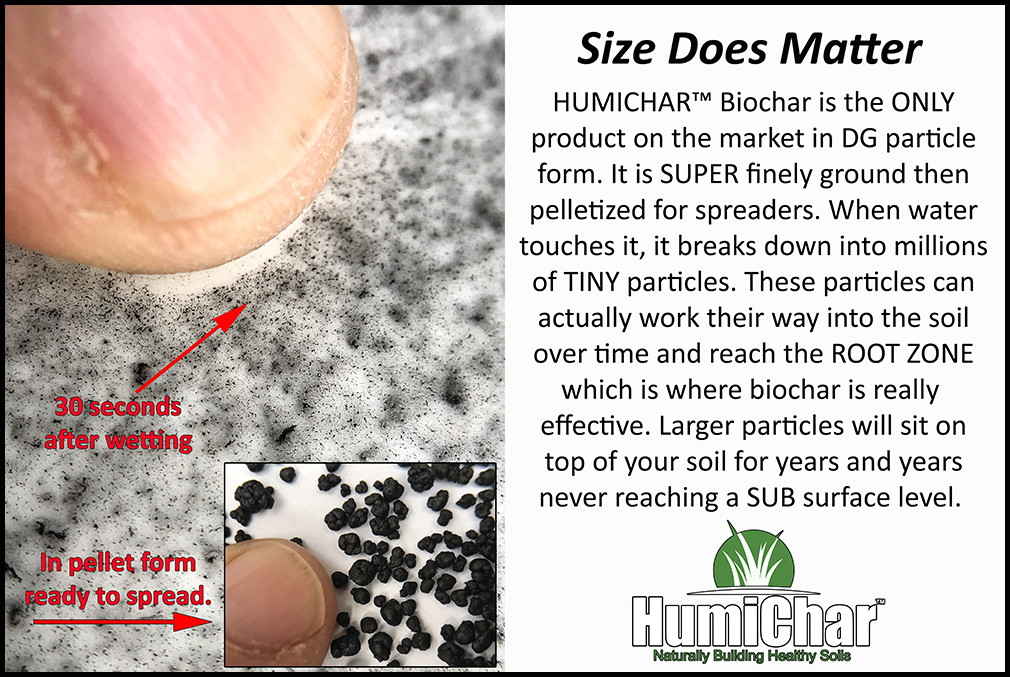
Personal Note from Doc…
BIOCHAR has been researched, proven effective for decades, and it helps hold nutrients and create a good environment for soil microbes. People often confuse it with a “nutrient” but it’s NOT. It’s a way to improve poor soils. I strongly recommend you watch the video below. (It will remind you of those old videos from school, but it REALLY shows the history well)
Your Soil Sucks…
Adding Organic Matter
NOTE: Adding organic matter to your lawn should be done when soil temps are 65 degrees and above. This is when microbes and fungus become active and they are NEEDED for the breakdown.
Soil microbes are GOOD… mycorrhizal fungi in soils are GREAT for lawns. Both play critical roles in the health of your lawn. However, both need quality ORGANIC matter to survive. This is why we created DIRT BOOSTER.
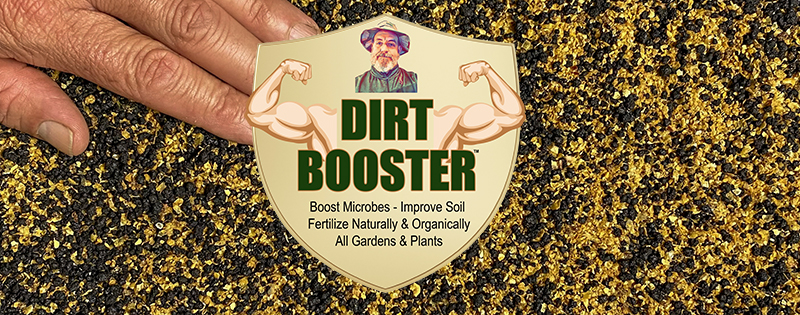
DirtBooster can be applied to your lawn in a spreader, then spray it with the microbe and fungus booster pack which is included. Do this when temps are warmer, above 80 degrees, and do this as often as you want.
The video below explains the benefits
Increasing good microbes and good fungus can also help reduce thatch build up problems. There is an extensive article on this subject that Doc really likes. It can be found → HERE
Cool Season Lawn Fertilizers
First… why we DON’T LOVE… organic fertilizers on cool season grasses. (The timing doesn’t match)
Organic lawn fertilizers either contain waste products or plant based products such as soybean. Both of these must be BROKEN DOWN via microbe / fungus decomposition before nutrients are released. (Just spreading them on your lawn will NOT add nutrients) This “break down” process only occurs rapidly in warmer temps. However this goes AGAINST our target fertilization times which is usually in the cooler weather.
Therefore, we prefer STANDARD type, direct nutrient fertilizers like → PGF Complete. Chemical fertilizers do NOT rely on temperature, microbes, or fungus to start working. Organics can be used effectively in the warmer months, but by then we generally “tone back” our feeding of cool season lawns.
When to Fertilize
The chart below will help you visualize the times for fertilizers. Note the difference between warm season grasses and cool season grasses and also strong slow release vs. mild supplements.
Which Fertilizer “Numbers” to Use
Every university extension office (see below) will say the same thing. Without a soil test, a fertilizer with a 4-1-2 ratio should be used. (Nitrogen – Phosphorus – Potassium) Remember 16-4-8 and 32-8-16 fertilizers are a 4-1-2 ratio. The numbers simply represent the strength or percentage by weight.
PGF Complete is the perfect fertilizer because it’s mild, slow release with ideal ratio and has TINY particles for good distribution. In addition, can be applied in intervals of 3 weeks up to 8 weeks during the growing season.
Example statements from Unv Ext offices…
“In most cases, a rate of one pound of nitrogen per 1,000 square feet is suggested for each fertilizer application to the lawn. If high percentage nitrogen fertilizers are used, then less actual fertilizer product is needed to supply that one pound compared to fertilizers with low percent nitrogen. Recommended ratios of N-P-K for lawn fertilizers include 3:1:2 or 4:1:2” → Link to Citation
“Good maintenance type fertilizers should be in a 3-1-2 ratio of nitrogen (N) to phosphorus (P) to potassium (K). An example of a 3-1-2 ratio fertilizer would be a 15-5-10 or something relatively close to this.” → Link to Citation
“If you have not had a soil test, apply a fertilizer that is four to six parts nitrogen, one part phosphorus and two to four parts potassium. A 16-4-8 fertilizer analysis would fall within this range with a 4-1-2 ratio of these nutrients.” → Link to Citation
“Use a 3-1-2 or 4-1-2 ratio fertilizer if you elect not to conduct a soil test. A common example of a 3-1-2 ratio fertilizer is 15-5-10,while a good 4-1-2 ratio fertilizer is 16-4-8.These ratios generally supply what most lawns need, and they won’t dramatically increase the phosphorus levels if it’s unneeded” → Link to Citation
When do we vary these numbers?
Generally there are only two times we vary these numbers.
1- A soil test shows an EXCESS or DEFICIENCY of a nutrient. When that shows we need to adjust our numbers. At that point we may use something like → PGF Balance to increase low phosphorus or PGF 16-0-8 for high phosphorus.
2- We are either in a period of GREEN UP, (late spring) higher nitrogen requirements, or a slow growth period, (late fall) lower number of nitrogen requirements.
Fertilizer Myths
Myth #1 – “I’m going to feed my plants”. We don’t “feed” the plant, we feed the soil. From that soil feeding, the plant draws what it needs for health and growth. The one exception is foliar uptake, but that is minimal on most plants.
Myth #2 – “Adding a LOT of “X” nutrient will help roots grow.” A plant only requires a certain amount of a nutrient to grow at its peak potential. As an example… using a scale of 1-10, if a plant requires a “5 out of 10” of potassium for best root growth, adding MORE potassium above this amount will NOT increase root growth. In other words, adding excess of a nutrient will not generate a “better” response. In fact it can have negative impacts. That’s why lawns with HIGH phosphorus need to be adjusted because high phosphorus can LOCK UP nutrients in the soil.
Understanding Supplements
Supplements like → Super Juice and → Green Shocker (picture below) are NOT base fertilizers, they are what their name implies… supplemental nutrients and products. Because they are mild they can be used in conjunction with slow release fertilizer programs or used during periods of stress like summer. They can also be used to “green up” a lawn before an “event”.
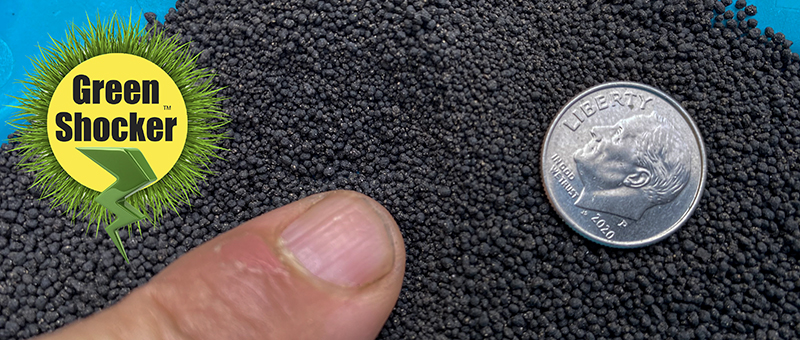
Summer Fertilizing
Pay Close Attention…
Just about everything you read will tell you NOT to fertilize in the summer months. You are told this because the “average homeowner” might run out and dump strong, slow release fertilizers designed for spring or fall. This will cause a surge in growth during stressful conditions and SHOULD NOT be done. However, you CAN feed your cool season grass in the summer as long as you understand SPOON FEEDING.
What is spoon feeding?
Spoon feeding is the process of applying a small amount of nutrients (usually more often) to the turf / soil in such an amount that will benefit the plant but NOT cause excess energy / growth. This often includes a touch of iron to darker the green color.
If you have a cool season lawn, you’re not in a drought, have irrigation, or have several days of rain approaching, you can do a spoon feeding. Keep in mind you also should not have recently applied strong long-term applications either. You can spoon feed your lawn with Super Juice or GreenShocker.
Winterizing Your Lawn
There is MUCH debate whether lawns should be “winterized” but here is the SIMPLE answer. If you have been following our program throughout the year, and applying a 16-4-8 or 16-0-8 fertilizer you probably don’t need to do anything to your lawn. Remember, we put nutrients into the soil, not the plant, and those nutrients are still there.
Potassium plays the key role in winterizing because it has been shown to enhance cold tolerance of turf grasses. If a soil test indicates that your soil is LOW in potassium, which it probably isn’t, it can be applied at a rate of 1 pound of potash per 1000 square feet of lawn. If your lawn is being grown on very sandy soils and there has been excessive rainfall during the growing season, additional potassium applications may be needed.
Be aware that an excessively high rate of potassium fertilizer can cause foliar burn, may compete with other nutrients for uptake, or may increase grass susceptibility to certain diseases. Excessive potassium is especially known to affect how much magnesium is taken up by grass, which will result in a lighter green turf color.
Aeration of Lawns
Aeration of lawns should always be done during a strong GROWING period. This will help the lawn recover and fill in. Aeration helps relieve soil COMPACTION, and allows water and oxygen to enter deep into the soil.
Aeration will work better / be easier if the lawn is cut fairly short. It’s HARD to pick up plugs on a cool season grass unless the grass is cut very low. However, we prefer to pick them as explained in the video below.
De-thatching Your Cool Season Lawn
Shorter grass and shorter cuts (1/4″ to 1″) seldom need dethatching. The small clippings fall into the thatch and are processed fairly rapidly. Also a thatch layer of about 1/2″ is healthy for your lawn and soil. However, on longer cool season lawns excess thatch buildup happens quite often. A SPRING TINE dethatcher is used to PULL UP the dead grass and it should be raked up.
Dethatching can be done as part of a late winter / early spring cleanup or done during the growing season.
Bugs and Grubs
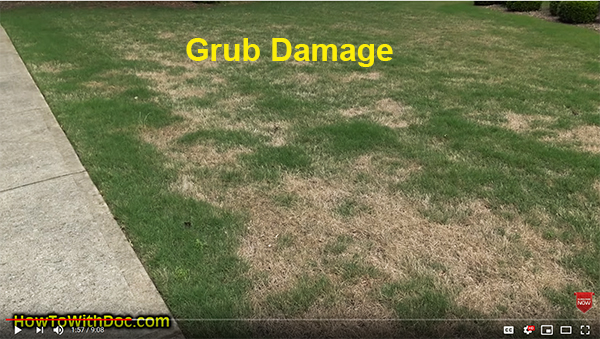
This could be an endless subject addressing 100s of “pest problems”, however we are going to keep it simple. The two most common lawn damage pests are white grubs and armyworms.
Grubs eat the ROOTS of the lawn causing medium to large brown patches in the lawn. Armyworms eat the blades of grass. Beetles form the grubs, and moths lay the armyworm eggs.
The simplest way to handle these two pests is to do a treatment twice a year. Once in the late spring and once in the late summer / early fall. We treat them with the → “doucide granules” which are spread on the lawn and then watered in.
If your armyworm problem is BIG… you can also spray your lawn with a HOSE END, over the counter lawn pest spray like this one. → Bayer Spray
Note from Pope… “Duocide is a very good army worm control at 4lb rate. I use it for Ants, fleas, ticks, and grubs last week of May for 1st app and timing. 2nd app for army worm ,white grubs or both 2nd week August to 1st week of September.”
Fungus and Disease
Fungus and disease can be a frustrating problem but they generally appear during the slower stages of growth. i.e. summer stress months. Very good read about lawn disease is from Purdue Unv and located → HERE
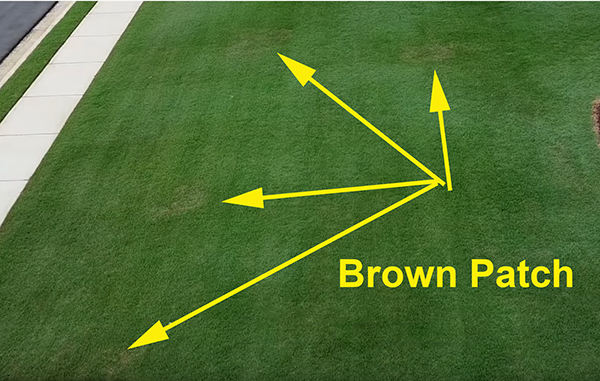
If you want pictures to help you ID your disease look → HERE
We like to apply the → granular fungicide in the spring as the weather warms up as a preventative. However, sprays may also be required to TREAT active problems and can be bought at lost “big box” stores. It is VERY important that you READ and FOLLOW the labels.
Leveling Your Lawn
Leveling your lawn comes in two basic forms. Spot leveling for larger ruts and bumps and minor overall leveling to have that “perfectly smooth” lawn. Deeper ruts will need to filled with a higher amount of quality soil (more organic matter), while minor leveling can be done with leveling mix / sand. Deep ruts with lots of fill soil will also have to be reseeded.
This must be done during the active growing season. When leveling it’s critical to understand that we are leveling the GROUND / soil and not the grass. So, grass must be cut as short as possible without damaging it. If you level your lawn with LONG grass, the leveling mix not evenly lay on the ground and it will CLUMP causing a mess.
Rolling your lawn?
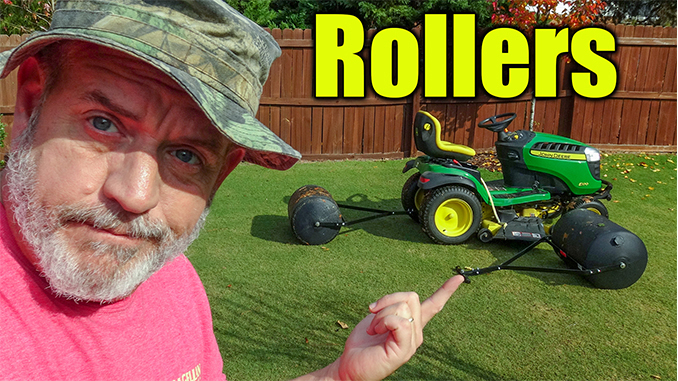
We have tested consumer grade rollers you fill with water or sand. In all cases we have found that the pressure / sq inch of these rollers is insufficient to make much of an improvement (if any). Also, the soil must be VERY wet to move at all. We say don’t bother. There are commercial companies that will come roll northern lawns with small “pavement rollers”. This can be very effective in lawns that suffer from frost heave. NOTE: if you do decide to get a roller and fill it with sand, you may not be able to use it due to the weight.
Cool Season Lawn Mowers
The majority of cool season lawns are best cut with a rotary type mower. These mowers LIFT the longer blades while cutting them. VERY short lawns (lower than 1″) are often cut with a reel mower. Reel mowers do NOT perform well on longer grasses. (above 1″) It’s critical to keep your blades sharp and we suggest buying an extra blade so you can rotate often. Dull blades RIP and TEAR the grass vs. giving a smooth cut. Making an investment in a good quality mower might “hurt” a bit, but over time you will see the difference.
How Often to Cut
When it comes to cutting lawns, the more often, and less taken off, is better. One of the worst things you can do is let your lawn OVER GROW, then cut it WAY down. We see this often with “lazy” homeowners that only cut their lawn every 2-3 weeks. The clippings pile up, the lawn looks ugly and all kinds of problems happen. Lawns should be cut EVERY week during the growing season and during times of peak growth it may require more. We cut our VERY short lawns, 1/2″ tall, every 2-3 days.
Watering Your Lawn
Established lawns should NOT be kept “wet” all the time. This can cause fungus and chlorosis issues. They should go through a normal cycle of deep watering and drying out. The rule of thumb is that for established lawns we water DEEPER and less often. So, 1″ of actual water per week.
This is NOT the case for newer lawns with shallow roots, especially during a drought period. Newly sodded lawns and newly seeded lawns may need short waterings 2 -3 time a day for the first few weeks, then every other day once newly established, then 3-4 times a week during the heat. Doc discusses short watering vs. long water cycles in this video.
Many lawns will also have “hot spots”. These are areas where below the surface something is causing the lawn to dry out FAST. In our yards tree roots and construction debris areas dry out 5 times fast than the rest of the yard. We often have to hand water these spots during hot weather.
Killing Weeds
#1 – We DON’T like granular weed killing products or combo products such as “weed and feed”. They don’t work that well. We prefer liquids. #2 If you are buying a product to kill weeds, READ THE LABEL. (watch video below) If you have weeds, identify them with a → Weed ID website then we like to use the ready to spray hose end bottles sold at most stores. Watch the video and learn. Most of the weeds killers will say do NOT apply above 85 degrees or during times of heat stress.
Seeding Your Lawn
The “rule of thumb” for COOL season grasses, is that seeding is done in the FALL so that roots have time to develop before getting hit with summer heat. So, the bulk of seeding is done during that period. However, MANY people do overseed their lawns in the spring with good results. Most of those have irrigation systems.
Cool season seeds like to be planted shallow. They should be planted anywhere from 1/8″ to 1/2″ in the soil. Doc likes to scarify the lawn after the seed has been spread out. Watch the video below.
The “FUN” part about cool season grasses is that the seeds generally germinate fairly quickly and lawns establish fast compared to warm season grasses like Bermuda or Zoysia. Also you can easily blend types of grasses or even kill off the entire lawn and reseed in a new lawn type.
Note from Pope… “If your cool season lawn is NOT performing well, you may want to consider introducing some diversity into it where primary species may not be performing well.”
Season By Season Care
The visual calendar is → HERE
Winter – Your lawn is “asleep” / dormant and nothing really to do at this point. If you don’t have snow on the ground THIS… is the time to make heavy PH adjustments and add carbon to your soil with → HUMICHAR Carbon takes a LONG time to work into the soil depths so starting now will have it deeper in the soil when we start the spring care.
Late Winter / Very Early Spring
This is the time to apply pre-emergent to your established lawn. It’s better to have the pre-emergent down 2 weeks before your recommended or “target date” which is determined by your soil temp. Most will say a soil temp of 51 – 53 degrees is when you apply. → SOIL TEMP MAP
Next, start the jump start program.
Your soil has been sitting all winter long with nothing done to it. Many nutrients have been leeching out and soil microbes and good fungus are pretty much nonexistent. We call this the “post winter wasteland”. We want our grass to WAKE UP into a healthy environment without HEAVY levels of nitrogen. So, about the time you put down your pre-emergent, put down a coat of → PGF BALANCE. This is a VERY fine particle, 10-10-10, all fast release fertilizer for lawns. This will inject your soil with a mild level of nutrients for when it first wakes up. Clean up of dead leaves and yard waste starts to happen.
Early Spring –
Time to cut the dead grass off the lawn. Take it LOW and remove all the dead brown grass. Bag it up and remove it from the lawn. Next, if you have a heavy thatch layer, you may want to consider a light dethatching as well.
As temps start to rise and green haze starts to cover your entire lawn, it’s time to put down your main feeding / base fertilizer, PGF Complete.
Spring –
Overseeding can be done with the understanding that as summer approaches this may require heavier irrigation than the established grass. Grub killer can be applied as well as curative or preventative fungicides. Dethatching, aeration, and leveling may also be started once the grass is growing and healthy. Once daytime temps reach high 70’s organic treatments like Dirt Booster may be applied.
Summer –
Watch for diseases and treat. Strong, slow release, base fertilizers should NOT be applied at this time. Instead switch of to LIGHT supplemental feedings with products like Green Shocker or Super Juice. Apply these just before a rain event and avoid using ANY FEEDING during long droughts. Cutting height is usually increased up 1/2 to 1″ taller than the spring cut. Lawn should NOT be allowed to totally dry out for extended periods or it may turn brown and go summer dormant.
Late Summer / Early Fall –
Watch for armyworms and treat for grubs. GreenShocker may be used until temps fall into the high 70s. At that point you can switch back to a slow release PGF Complete. Cutting height can be brought back down to normal height. Aeration and seeding usually takes place at this time. Do NOT apply any pre-emergents if you plan to seed.
Fall into Late Fall –
Your slow release fertilizer application should hold you through this period. If you want to add more, use a fast release fertilizer like Green Shocker. As the colder weather approaches, and grass slows it’s growth, put out a light coat of PGF Balance 10-10-10. This will be your last treatment of the fall going into winter. As temps REALLY start to drop,winter is approaching, and growth totally stops, you can apply your winter pre-emergent.

For more information and weekly “how to videos” subscribe to our YouTube Channel → HERE

